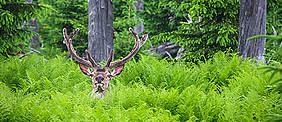Red deer surf the green wave
01/27/2017Climate change is affecting vegetation also in our latitudes. For the first time, scientists have conducted experiments to determine to what extent wild animals are capable of adjusting to this change.

The green shoots of spring are especially high in energy. Over the year, the plants' forage quality degrades continuously. In the mountains, the greening process in spring proceeds from bottom to top. At best, a lot of animals closely follow this green wave. But climate change is affecting this rhythm. When winters are short, the green shoots occur much earlier than many animals are used to. Are the wild animals capable of adjusting to this?
Researchers of the universities of Oslo, Würzburg and Freiburg have looked into this question by conducting experiments in the Bavarian Forest National Park for the first time. Jörg Müller, Professor of Animal Ecology and Tropical Biology at the University of Würzburg, was in charge of the study and headed the research activities in the Bavarian Forest National Park. The Bavarian Forest provides the necessary infrastructure for the experiments, as the majority of deer spend the cold season in four winter enclosures.
20 deer equipped with GPS trackers
For the experiment, the scientists fitted 20 deer with GPS tracking devices. Half of the animals were given immediate access to fresh greens in spring, whereas the other half had to wait six more weeks before they were set free to forage.
The results published in the scientific journal "Ecology" show that the animals deliberately seek out the fresh and nutrient-rich vegetation. The deer that had left their winter enclosures early "surfed" the green wave directly from the valley to the high regions. But also the animals released later were highly flexible. They just run uphill more quickly to where better forage was to be found.
Unexpected level of flexibility
"This behaviour had been observed for many years, but for the first time the experiment actually proved the red deer's high level of individual flexibility to adjust to changed environmental conditions," Jörg Müller sums up the study results. Or briefly put: "The animals are capable of adjusting quickly and flexibly." An ability that leaves them well-prepared to face climate change.
Green wave tracking by large herbivores: an experimental approach. Rivrud Inger Maren; Heurich Marco; Krupczynski Philipp; Müller Jörg, Mysterud Atle: In: Ecology. Ecological Society of America (Volume 97, Issue 12). DOI: 10.1002/ecy.1596/full








